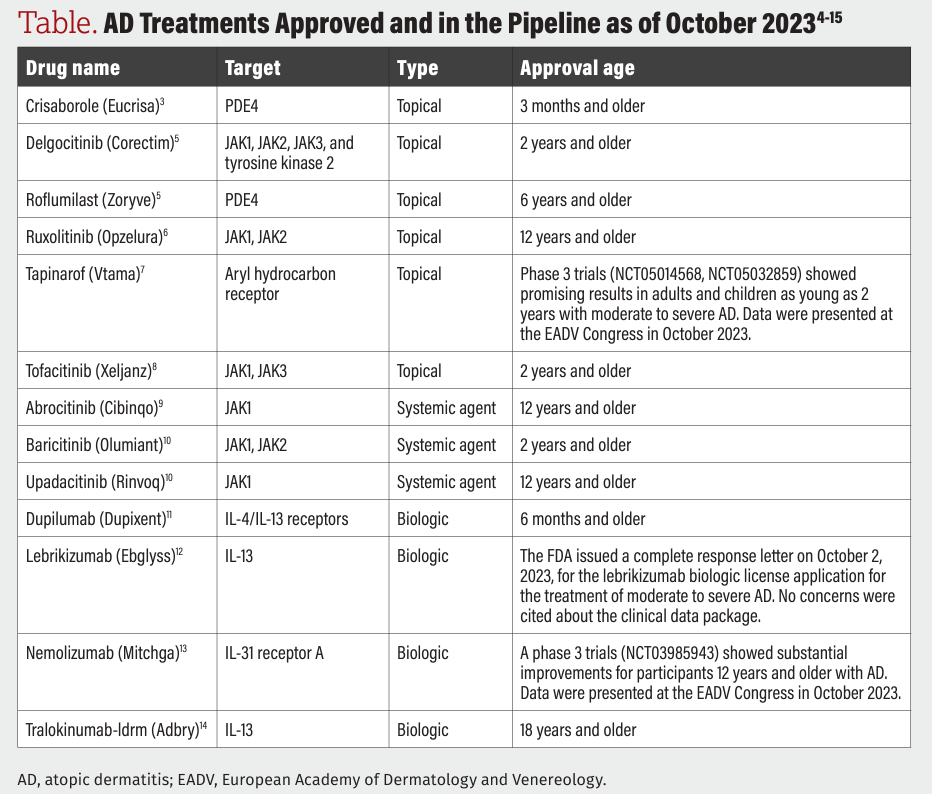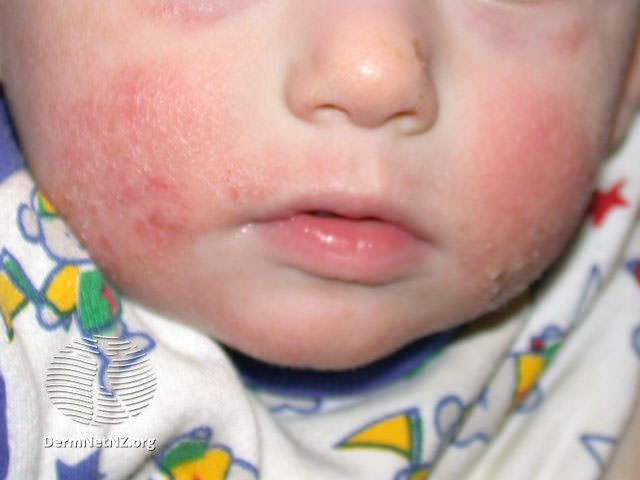- Case-Based Roundtable
- General Dermatology
- Eczema
- Chronic Hand Eczema
- Alopecia
- Aesthetics
- Vitiligo
- COVID-19
- Actinic Keratosis
- Precision Medicine and Biologics
- Rare Disease
- Wound Care
- Rosacea
- Psoriasis
- Psoriatic Arthritis
- Atopic Dermatitis
- Melasma
- NP and PA
- Skin Cancer
- Hidradenitis Suppurativa
- Drug Watch
- Pigmentary Disorders
- Acne
- Pediatric Dermatology
- Practice Management
- Prurigo Nodularis
- Buy-and-Bill
Publication
Article
Dermatology Times
Key Considerations for Optimal Atopic Dermatitis Care Across All Ages
From the November cover: Raj Chovatiya, MD, PhD, and Lawrence Eichenfield, MD, shared their insights and key treatment pearls into atopic dermatitis management for adults and children.
Understanding the clinical presentations in adult versus pediatric patients is crucial for making an accurate diagnosis and then developing an appropriate treatment regimen. In an interview with Dermatology Times, Raj Chovatiya, MD, PhD, and Lawrence Eichenfield, MD, shared their insights and key treatment pearls.
Chovatiya is an assistant professor of dermatology and director for the Center of Eczema and Itch and Medical Director of the clinical trials unit at Northwestern University Feinberg School of Medicine in Chicago, Illinois. He also serves on the Dermatology Times Editorial Advisory Board.
Eichenfield is chief of pediatric and adolescent dermatology at Rady Children’s Hospital–San Diego and a professor of dermatology and pediatrics and vice chair of the Department of Dermatology at the University of California San Diego School of Medicine.
Presentations Differences
Although certain fundamental characteristics of AD remain consistent across age groups, such as lesions in flexural areas, a history of atopy, and xerosis, there are noteworthy differences. AD is more prevalent in pediatric patients, but Chovatiya explained that there is a better understanding of adult-onset AD.
In adults, there is a greater presence of chronic disease indicators, an elevated occurrence and diverse patterns of hand eczema, and a more pronounced connection between disease activity and emotional factors. Conversely, children with AD tend to display a higher prevalence of exudative lesions, perifollicular accentuation, pityriasis alba, and Dennie-Morgan folds, with a presentation reminiscent of seborrheic dermatitis.1
These distinctions may be attributed, in part, to variances in the underlying pathophysiology in children compared with adults. Other atopic conditions frequently co-occur with AD, although they do not always follow a sequential progression known as the “atopic march.” Further research is needed to gain a deeper understanding of how immune dysregulation, disruptions in the skin’s barrier function, and alterations in microbial communities differ between children and adults and whether these variances have implications for the effectiveness of therapeutic interventions.1
Diagnostic Approaches
With pediatric AD closely connected to persistent AD into adulthood,2 it is important to understand how pediatric management has evolved. According to Eichenfield, the number of children with AD has stabilized over the past decade, but when comparing the past several decades, there is a much higher rate of pediatric AD.
“We have around a 10% to 12% rate of young children with atopic dermatitis, but some newer data, and pretty strong data, show that we have probably 7% of adults with atopic dermatitis, of [whom] probably half [are] left over from childhood,” said Eichenfield. “Our prior assessment was that atopic dermatitis was a young childhood disease and it got better over time. The epidemiology is a little bit different. The why is tricky; they’re really competing theories.”
Eichenfield noted this could be related to immune systems being vulnerable and set up to hyper respond, with increased rates of eczema also being similar to increased rates of allergens, food allergies, and asthma.
Treatment Considerations
All around, standard first-line treatment for AD includes having good bathing practices, moisturizing after bathing, and choosing an ideal ointment or lotion for each patient, according to Eichenfield.
“Clearly, the biggest changes in our go-tos are that our go-tos are expanding for treatment of the inflammation of eczema that doesn’t respond to moisturizer, which is a lot of inflammation in eczema,” Eichenfield said. “Traditionally, we use topical corticosteroids, but then we had to limit our frequency of use—or our persistent use of topical corticosteroids—because of concerns about too much absorption or thinning of the skin.”
Eichenfield discussed the use of topical corticosteroids or topical nonsteroidal agents to get AD under control and then the use of nonsteroidal topical agents to keep the AD under control. Eichenfield specifically mentioned tapinarof, an aryl hydrocarbon receptor agonist with the potential unique ability to create a remittive effect (enabling time off therapy).
Eichenfield said other promising nonsteroidals topicals include ruxolitinib and roflumilast.
“I think that having nonsteroids could be incredibly important... Where someone can have periods when they’re free of rash, free of itch, and [have] minimal concerns about using the topical products if they’re tolerated well with good [adverse] effect profiles and no concerns about toxicity,” Eichenfield said.
Chovatiya explained that although there are fewer approved options for pediatric and adolescent patients with AD than adults, AD treatment challenges evolve with the age of the patient. Thus, in adults, it is important to take a deeper dive into their lifestyles and comorbidities.

“We’re really trying to come up with recommendations for older age and what might be a good choice [or a] bad choice, knowing that as you get older, certain comorbidities might present themselves that did not exist when you were younger,” Chovatiya said. “That may change the medication that you use. For instance, in the case of oral JAK [Janus kinase] inhibitors, based on their box warning, labeling similar comorbidities you’d want to avoid that might theoretically be present in an older individual, which makes your therapeutic choice a little different, vs whether or not somebody can even manage a systemic therapy with older age and whether a topical might be a better choice for [them] as well.”
Chovatiya noted the importance of asking lifestyle questions beyond health history. “Can somebody really tolerate injections without a problem?” Chovatiya asked. “Can they store injections? Do they not have the capacity to do so? Do they travel quite a bit? Is oral dosing something that’s better for them because they prefer that [it] is flexible, and they sort of need a higher dose and a lower dose…available [to them]? Is systemic therapy, a nonstarter and topical is just something that someone is used to, [so] that’s what they want to do? And that’s what we’re going to optimize.”
Multidisciplinary Care
Chovatiya delved into the importance of multidisciplinary care, as AD can contribute to anxiety, depression, attention-deficit/hyperactivity disorder, and sleep impairment as well as musculoskeletal, metabolic, and cardiovascular diseases.
He likes to “bring in specialists to the clinic every once in a while for the right type(s) of patient(s) who may need psychiatric help, sleep help, or the most classic would be allergy help—knowing that there’s a high burden of asthma, rhinosinusitis, and food allergy in this population,” Chovatiya said.
He encourages colleagues to ask questions about symptoms to make optimal referrals. He also encourages thinking about what is in your toolbox based on rural, suburban, urban location, and population.
“I like to track these symptoms over time so I can get a better [understanding of] what’s affecting [the patient] the most,” Chovatiya explained. “It’s up to us to be creative to make sure that we’re connecting our patients to the right health care.”
Collaborating with pediatricians is key for children with AD.
Eichenfield stressed the importance of working with and educating pediatricians. He was part of a multiyear AD initiative with pediatricians that included education and the development and distribution of information. The goal of the initiative, he said, was to increase pediatricians’ comfort in managing AD via education on changing therapies.3
Insight From the Doc: Misinformation on TikTok
One surprising area of concern in pediatric atopic dermatitis (AD) is misinformation on social media platforms, especially TikTok, according to Eichenfield.
“I think we probably need education now more than ever because, partially, people get their information in so many different ways....I have people come in and they’re quoting their TikTok videos, and maybe it’s a good TikTok video, but there are some bad ones,” Eichenfield said.
Eichenfield has had pediatric patients with AD who are admitted to the hospital with serious infections due to extreme itching from eczema. As a physician, he is worried about infections migrating to the bloodstream, but some parents or caregivers are still against using medication because they are concerned about what they heard (ie, misinformation) on social media.
Along with the problem of misinformation, Eichenfield also noted that because some parents and caregivers have misgivings about currently available therapeutics, there is a disconnect between the physician and parent/caregiver. Eichenfield said it is important to support and encourage education rather than to judge those who have concerns about traditional therapies.
What are your treatment challenges and clinical pearls for supporting adults and youth patients with AD? Share case discussions with us via DTEditor@mmhgroup.com and your insights might get published in an upcoming issue.
References
1. Ramírez-Marín HA, Silverberg JI. Differences between pediatric and adult atopic dermatitis. Pediatr Dermatol. 2022;39(3):345-353. doi:10.1111/pde.14971
2. Lee SS, Kaushik A, Natsis N, et al. A multimodal initiative improves general pediatric provider management of atopic dermatitis in children: a prospective interventional study. J Am Acad Dermatol. 2023;89(5):1041-1044. doi:10.1016/j.jaad.2023.02.065
3. Woo TE, Kuzel P. Crisaborole 2% ointment (Eucrisa) for atopic dermatitis. Skin Therapy Lett. 2019;24(2):4-6.
4. Ho J, Molin S. Delgocitinib in atopic dermatitis. Drugs Today (Barc). 2021;57(12):719-731. doi:10.1358/dot.2021.57.12.3352760
5. Kleinman E, Laborada J, Metterle L, Eichenfield LF. What’s new in topicals for atopic dermatitis? Am J Clin Dermatol. 2022;23(5):595-603. doi:10.1007/s40257-022-00712-0
6. Chovatiya R, Paller AS. JAK inhibitors in the treatment of atopic dermatitis. J Allergy Clin Immunol. 2021;148(4):927-940. doi:10.1016/j.jaci.2021.08.009
7. Dermavant announces new positive pruritus data for Vtama (tapinarof) cream, 1% in adults and children as young as two years old with atopic dermatitis at EADV Congress 2023. News release. Dermavant Sciences. October 12, 2023. Accessed October 12, 2023. https://www.dermavant.com/dermavant-announces-new-positive-pruritus-data-for-vtamatapinarof-cream-1-in-adults-and-children-as-young-as-two-years-old-with-atopic-dermatitis-at-the-eadv-congress-2023/
8. Nakashima C, Yanagihara S, Otsuka A. Innovation in the treatment of atopic dermatitis: emerging topical and oral Janus kinase inhibitors. Allergol Int. 2022;71(1):40-46. doi:10.1016/j.alit.2021.10.004
9. Reich K, Thyssen JP, Blauvelt A, et al. Efficacy and safety of abrocitinib versus dupilumab in adults with moderate-to-severe atopic dermatitis: a randomised, double-blind, multicentre phase 3 trial. Lancet. 2022;400(10348):273-282. doi:10.1016/S0140-6736(22)01199-0
10. Wan H, Jia H, Xia T, Zhang D. Comparative efficacy and safety of abrocitinib, baricitinib, and upadacitinib for moderate-to-severe atopic dermatitis: a network meta-analysis. Dermatol Ther. 2022;35(9):e15636. doi:10.1111/dth.15636
11. Li CY, Chen S, Qian WL, et al. [Clinical observation on the efficacy and safety of dupilumab in the treatment of moderate to severe atopic dermatitis] Abstract in English, Chinese. Zhonghua Yu Fang Yi Xue Za Zhi. 2023;57(10):1590-1595. doi:10.3760/cma.j.cn112150-20221103-01063
12. Nearly 80% of patients with moderate-to-severe atopic dermatitis maintained clear or almost clear skin with Lilly’s lebrikizumab monthly maintenance dosing at two years. News release. Eli Lilly and Company. October 20, 2023. Accessed October 20, 2023. https://investor.lilly.com/news-releases/news-release-details/nearly-80-patients-moderate-severe-atopic-dermatitis-maintained#:~:text=INDIANAPOLIS%20%2C%20Oct.%2020%2C%202023,demonstrated%20in%20the%20ADjoin%20long%2D
13. Wagner N, Loprete L, Duval V, et al. Selection of nemolizumab clinical dosage for atopic dermatitis. J Drugs Dermatol. 2023;22(10):1017-1020. doi:10.36849/JDD.7437R1
14. Simpson EL, Blauvelt A, Silverberg JI, et al. Tralokinumab provides clinically meaningful responses at week 16 in adults with moderate-to-severe atopic dermatitis who do not achieve IGA 0/1. Am J Clin Dermatol. Published online October 7, 2023. doi:10.1007/s40257-023-00817-0








